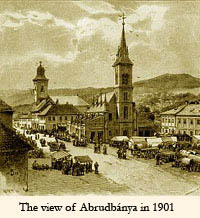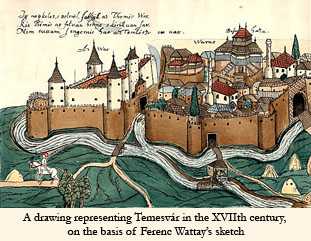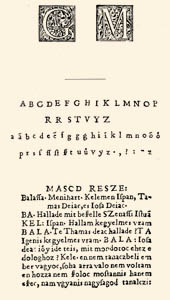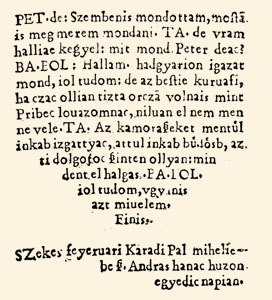Abrudbánya, Simánd, Temesvár
Pál Karádi (1523 – c.1590) Unitarian bishop, religious polemist, printer. There are very scarce contemporary sources about his life and printing shop. Until 1567 he was the pastor of Gergely Bethlen, Ban of Karánsebes in his court, and following the death of his patron he moved to Abrudbánya (Abrud, R), and the next year he took part in the second religious dispute at Gyulafehérvár (Alba Iulia, R)on behalf of the Unitarians.
For Unitarian (Antitrinitarian) book publishing it was of great significance, that the productive protestant printer-publisher Gáspár Heltai active in Kolozsvár (Cluj-Napoca, R) in the largest town of Transylvania, joined the Unitarian Church. From 1569 on his printing shop produced several books in this spirit. As a second, rather modest enterprise, Pál Karádi's press was also working for the Unitarians in Abrudbánya, in the same year.
 The town Abrudbánya situated in the Transylvanian Mineral Mountains was famous for its goldmine. It was here that Pál Karádi printed an anonymous politcal pamphlet with the title „Comoedia Balassi Menyhárt árultatásáról.”(RMNy 260). It survived in one single copy and it is the only product of Karádi's press extant. This booklet proves that he was not only a Unitarian preacher but he also promoted the spread of his confession through printing. We have no knowledge as to where and when he acquired the practice of printing, or about the source of his modest printing shop, neither about the exact date and place he began printing.
The town Abrudbánya situated in the Transylvanian Mineral Mountains was famous for its goldmine. It was here that Pál Karádi printed an anonymous politcal pamphlet with the title „Comoedia Balassi Menyhárt árultatásáról.”(RMNy 260). It survived in one single copy and it is the only product of Karádi's press extant. This booklet proves that he was not only a Unitarian preacher but he also promoted the spread of his confession through printing. We have no knowledge as to where and when he acquired the practice of printing, or about the source of his modest printing shop, neither about the exact date and place he began printing.
Contemporary sources prove that at the beginning of 1570 he was already the pastor of the market spot Simánd (Şimand, R) situated west-south-west to Abrudbánya, belonging to the territory of Hungary occupied at that time by the Osman Turks. The reason why he moved to Simánd fitted presumably into the aim of the Transylvanian Unitarians, namely, to convert Hungarian people living under Turkish occupation to Unitarian confession. It is very likely that here he also continued his printing activity, and might have taken part on behalf of the Unitarians with printed pamphlets, in the polemics between Calvinists and Unitarians, thus supporting the Unitarian bishop Ferenc Dávid. These must have been booklets of couple of leaves, printed probably in a low number of copies, which circumstance explains their complete disappearence by today. The printing activity of Karádi can be only supposed, there is no book known from his supposed printing shop in Simánd.
 The next year, in 1571, he moved further to Temesvár (Timişoara, R), belonging likewise to the territory of Hungary under Turkish occupation. Here, too, it is very likely, that he set up his printing shop, because according to contemporary sources he produced pamphlets of Unitarian confession, supporting Ferenc Dávid. However, there is no printing known from his eventual activity in Temesvár.
The next year, in 1571, he moved further to Temesvár (Timişoara, R), belonging likewise to the territory of Hungary under Turkish occupation. Here, too, it is very likely, that he set up his printing shop, because according to contemporary sources he produced pamphlets of Unitarian confession, supporting Ferenc Dávid. However, there is no printing known from his eventual activity in Temesvár.
Karádi's printing equipment was very poor: a single, rather archaic roman type and two decorated initials can be seen in his only printing, therefore, it is justified to say, that his was the smallest and most modest printing equipment in contemporary Hungary. However, in case any of his printings would crop up from the time of his activity in Simánd or Temesvár, these would be the first positive proofs of printing carried on in the central part of Hungary under Turkish occupation.
 |
 |
The printing equipment used by Pál Karádi in 1569 |
The name of the printer Pál Karádi in the colophon (RMNy 260) |
<<back to the top <<

LITERATURE:
KATONA Géza: Karádi Pál abrudbányai könyvnyomdája és annak végsora. = Református Egyház 1962. 180-181.
DÖRNYEI Sándor: A 16. századi simándi nyomda. = MKsz 1964. 172-174.
BALÁZS Mihály-KÁLDOS János: Karádi Pál nyomdája. In. Fata libelli. A nyolcvanéves Borsa Gedeon köszöntésére. Szerk. P. Vásárhelyi Judit. Bp. 2003. 215-228.
V. ECSEDY Judit: A régi magyarországi nyomdák betűi és díszei 1473-1600. Bp. 2004. 99-100.